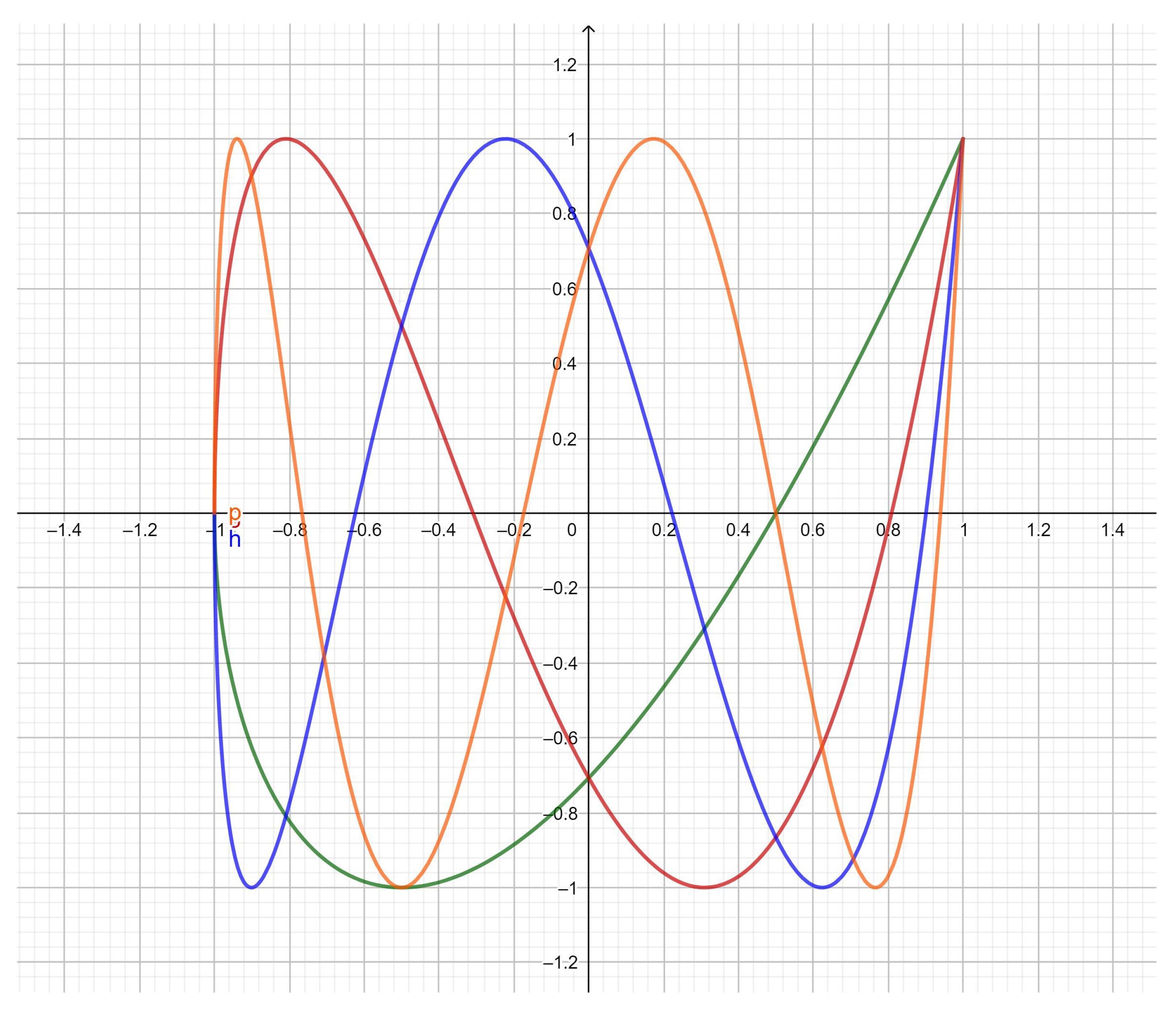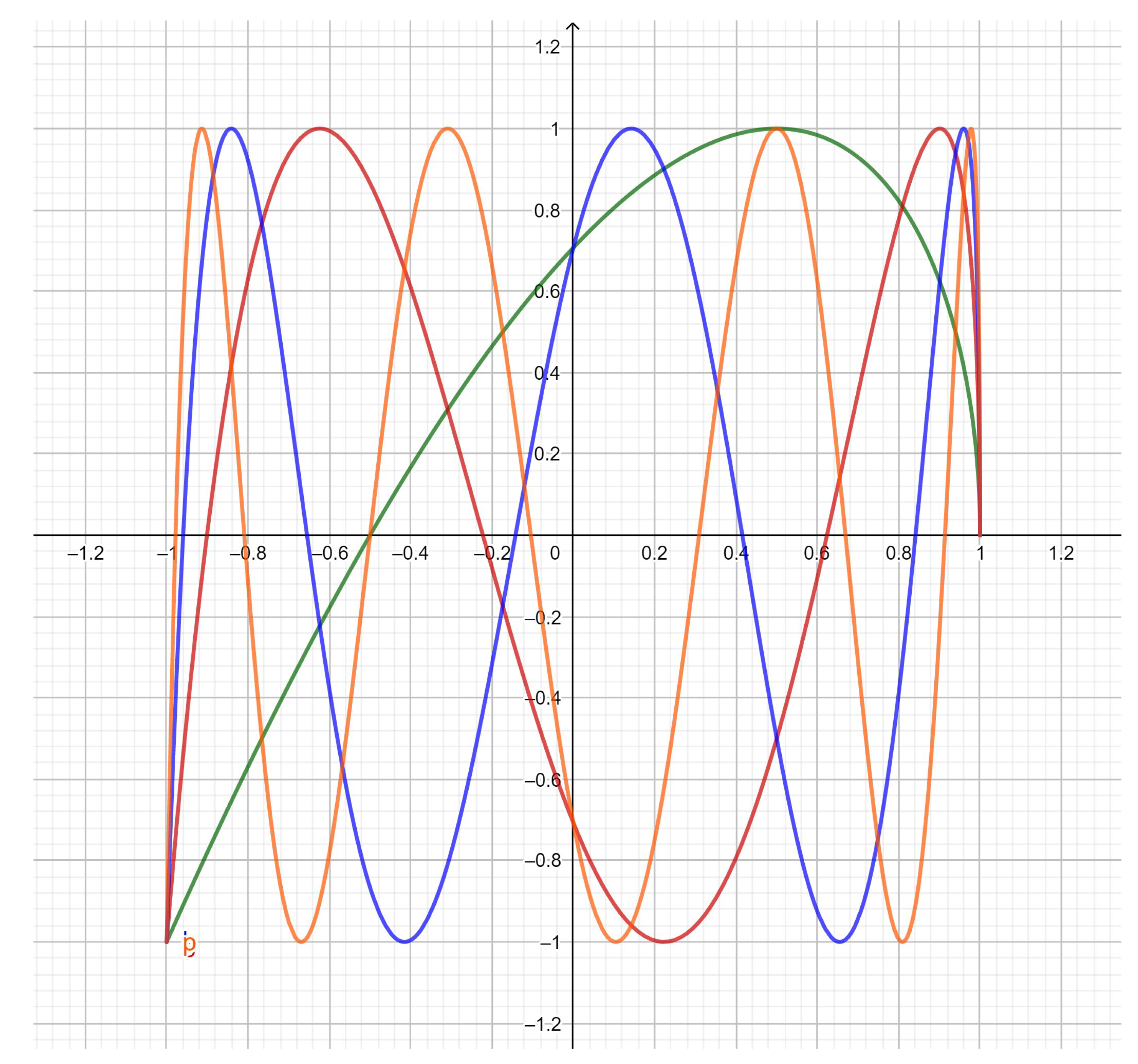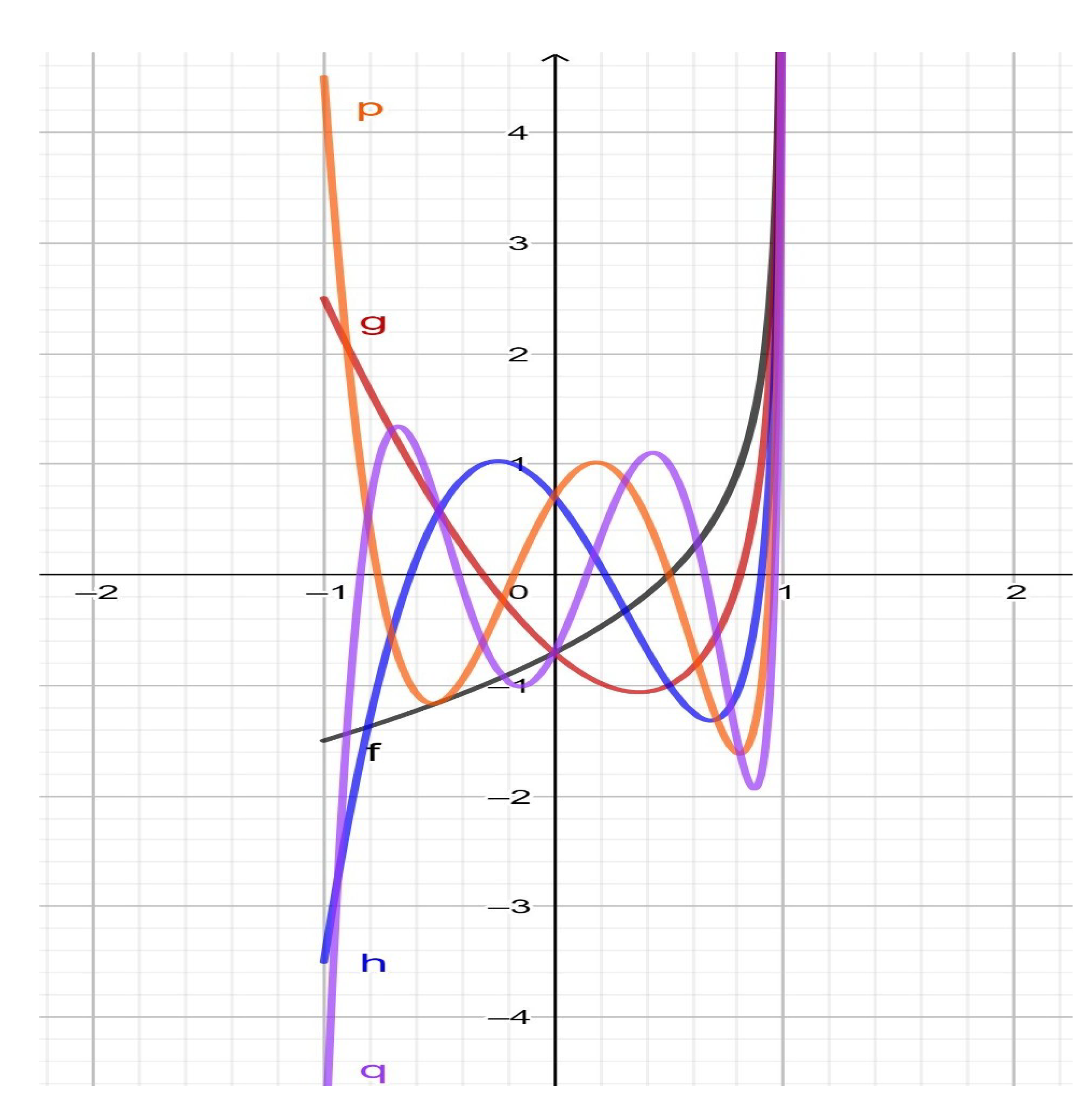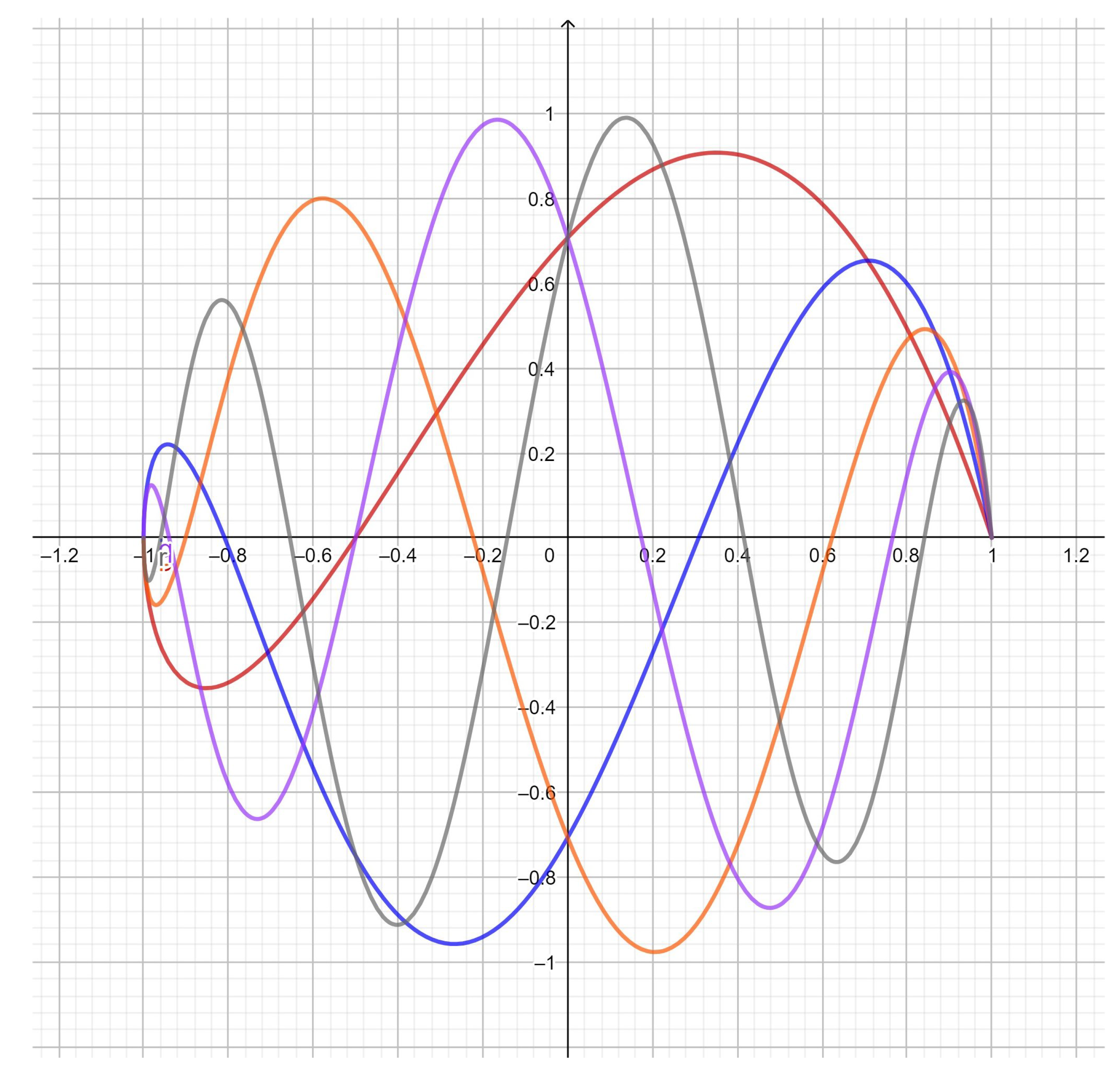The Third and Fourth Kind Pseudo-Chebyshev Polynomials of Half-Integer Degree
Abstract
:1. Introduction
2. Definitions of Pseudo-Chebyshev Functions
3. Properties of the First and Second Kind Pseudo-Chebyshev Functions
3.1. The First Kind Pseudo-Chebyshev
3.2. The Second Kind Pseudo-Chebyshev
4. The Third and Fourth Kind Pseudo-Chebyshev Functions
4.1. The Third Kind Pseudo-Chebyshev
4.2. The Fourth Kind Pseudo-Chebyshev
5. Further Properties of the Pseudo-Chebyshev Functions
5.1. Generating Functions
5.2. Explicit Forms
5.3. Location of Zeros
5.4. Hypergeometric Representations
5.5. Rodrigues-Type Formulas
6. Links with First and Second Kind Chebyshev Polynomials
7. Conclusions
Author Contributions
Funding
Conflicts of Interest
References
- Rivlin, T.J. The Chebyshev Polynomials; Wiley: Hoboken, NJ, USA, 1974. [Google Scholar]
- Ricci, P.E. Alcune osservazioni sulle potenze delle matrici del secondo ordine e sui polinomi di Tchebycheff di seconda specie. Atti della Accademia delle Scienze di Torino Classe di Scienze Fisiche Matematiche e Naturali 1975, 109, 405–410. [Google Scholar]
- Ricci, P.E. Sulle potenze di una matrice. Rend. Mat. 1976, 9, 179–194. [Google Scholar]
- Ricci, P.E. Una proprietà iterativa dei polinomi di Chebyshev di prima specie in più variabili. Rend. Mat. Appl. 1986, 6, 555–563. [Google Scholar]
- Cesarano, C. Identities and generating functions on Chebyshev polynomials. Georgian Math. J. 2012, 19, 427–440. [Google Scholar] [CrossRef]
- Cesarano, C. Integral representations and new generating functions of Chebyshev polynomials. Hacet. J. Math. Stat. 2015, 44, 535–546. [Google Scholar] [CrossRef]
- Cesarano, C.; Cennamo, G.M.; Placidi, L. Operational methods for Hermite polynomials with applications. WSEAS Trans. Math. 2014, 13, 925–931. [Google Scholar]
- Cesarano, C. Generalized Chebyshev polynomials. Hacet. J. Math. Stat. 2014, 43, 731–740. [Google Scholar]
- Cesarano, C.; Fornaro, C. Operational identities on generalized two-variable Chebyshev polynomials. Int. J. Pure Appl. Math. 2015, 100, 59–74. [Google Scholar] [CrossRef]
- Cesarano, C.; Fornaro, C. A note on two-variable Chebyshev polynomials. Georgian Math. J. 2017, 243, 339–349. [Google Scholar] [CrossRef]
- Mason, J.C.; Handscomb, D.C. Chebyshev Polynomials; Chapman and Hall: New York, NY, USA; CRC: Boca Raton, FL, USA, 2003. [Google Scholar]
- Boyd, J.P. Chebyshev and Fourier Spectral Methods, 2nd ed.; Dover: Mineola, NY, USA, 2001. [Google Scholar]
- Srivastava, H.M.; Ricci, P.E.; Natalini, P. A Family of Complex Appell Polynomial Sets. Rev. Real Acad. Sci. Cienc. Exactas Fis. Nat. Ser. A Math. 2018. [Google Scholar] [CrossRef]
- Ricci, P.E. Complex spirals and pseudo-Chebyshev polynomials of fractional degree. Symmetry 2018, 10, 671. [Google Scholar] [CrossRef]
- Gielis, J. The Geometrical Beauty of Plants; Atlantis Press: Paris, France; Springer: Berlin/Heidelberg, Germany, 2017. [Google Scholar]
- Aghigh, K.; Masjed-Jamei, M.; Dehghan, M. A survey on third and fourth kind of Chebyshev polynomials and their applications. Appl. Math. Comput. 2008, 199, 2–12. [Google Scholar] [CrossRef]
- Doha, E.H.; Abd-Elhameed, W.M.; Alsuyuti, M.M. On using third and fourth kinds Chebyshev polynomials for solving the integrated forms of high odd-order linear boundary value problems. J. Egypt. Math. Soc. 2015, 24, 397–405. [Google Scholar] [CrossRef]
- Kim, T.; Kim, D.S.; Dolgy, D.V.; Kwon, J. Sums of finite products of Chebyshev polynomials of the third and fourth kinds. Adv. Differ. Equ. 2018, 2018, 283. [Google Scholar] [CrossRef]




© 2019 by the authors. Licensee MDPI, Basel, Switzerland. This article is an open access article distributed under the terms and conditions of the Creative Commons Attribution (CC BY) license (http://creativecommons.org/licenses/by/4.0/).
Share and Cite
Cesarano, C.; Pinelas, S.; Ricci, P.E. The Third and Fourth Kind Pseudo-Chebyshev Polynomials of Half-Integer Degree. Symmetry 2019, 11, 274. https://doi.org/10.3390/sym11020274
Cesarano C, Pinelas S, Ricci PE. The Third and Fourth Kind Pseudo-Chebyshev Polynomials of Half-Integer Degree. Symmetry. 2019; 11(2):274. https://doi.org/10.3390/sym11020274
Chicago/Turabian StyleCesarano, Clemente, Sandra Pinelas, and Paolo Emilio Ricci. 2019. "The Third and Fourth Kind Pseudo-Chebyshev Polynomials of Half-Integer Degree" Symmetry 11, no. 2: 274. https://doi.org/10.3390/sym11020274
APA StyleCesarano, C., Pinelas, S., & Ricci, P. E. (2019). The Third and Fourth Kind Pseudo-Chebyshev Polynomials of Half-Integer Degree. Symmetry, 11(2), 274. https://doi.org/10.3390/sym11020274






